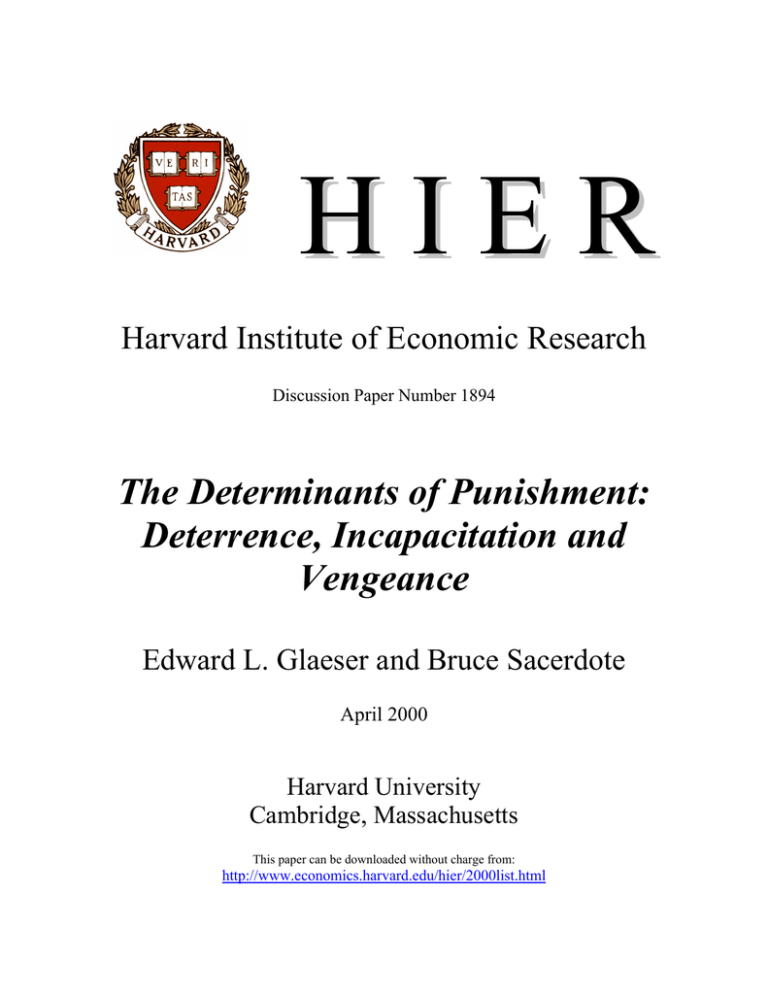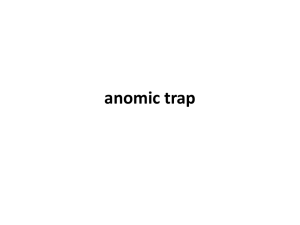
HIER
Harvard Institute of Economic Research
Discussion Paper Number 1894
The Determinants of Punishment:
Deterrence, Incapacitation and
Vengeance
Edward L. Glaeser and Bruce Sacerdote
April 2000
Harvard University
Cambridge, Massachusetts
This paper can be downloaded without charge from:
http://www.economics.harvard.edu/hier/2000list.html
HIER
Harvard Institute of Economic Research
Discussion Paper #1894
The Determinants of Punishment:
Deterrence, Incapacitation and
Vengeance
Edward L. Glaeser and Bruce Sacerdote
April 2000
Harvard University
Cambridge, Massachusetts
This paper can be downloaded without charge from:
http://www.economics.harvard.edu/hier/2000list.html
THE DETERMINANTS OF PUNISHMENT:
DETERRENCE, INCAPACITATION AND VENGEANCE
Edward L. Glaeser
Bruce Sacerdote
April 2000
Both authors thank the National Science Foundation. Steven Shavell, Steven Levitt, and participants in the
NBER Law and Economics group provided helpful comments. The views expressed herein are those of the
authors and are not necessarily those of the National Bureau of Economic Research.
© 2000 by Edward L. Glaeser and Bruce Sacerdote.. All rights reserved. Short sections of text, not to
exceed two paragraphs, may be quoted without explicit permission provided that full credit, including ©
notice, is given to the source.
The Determinants of Punishment: Deterrence, Incapacitation and Vengeance
Edward L. Glaeser and Bruce Sacerdote
April 2000
ABSTRACT
Does the economic model of optimal punishment explain the variation in the sentencing of
murderers? As the model predicts, we find that murderers with a high expected probability of
recidivism receive longer sentences. Sentences are longest in murder types where apprehension rates
are low, and where deterrence elasticities appear to be high. However, sentences respond to victim
characteristics in a way that is hard to reconcile with optimal punishment. In particular, victim
characteristics are important determinants of sentencing among vehicular homicides, where victims
are basically random and where the optimal punishment model predicts that victim characteristics
should be ignored. Among vehicular homicides, drivers who kill women get 56 percent longer
sentences. Drivers who kill blacks get 53 percent shorter sentences.
Edward L. Glaeser
Department of Economics
327 Littauer Center
Harvard University
Cambridge, MA 02138
and NBER
eglaeser@kuznets.harvard.edu
Bruce Sacerdote
Department of Economics
6106 Rockefeller Hall
Dartmouth College
Hanover, NH 03755
and NBER
bruce.i.sacerdote@dartmouth.edu




